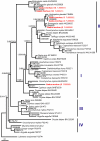Atlantic cod (Gadus morhua) hemoglobin genes: multiplicity and polymorphism
- PMID: 19728884
- PMCID: PMC2757024
- DOI: 10.1186/1471-2156-10-51
Atlantic cod (Gadus morhua) hemoglobin genes: multiplicity and polymorphism
Abstract
Background: Hemoglobin (Hb) polymorphism, assessed by protein gel electrophoresis, has been used almost exclusively to characterize the genetic structure of Atlantic cod (Gadus morhua) populations and to establish correlations with phenotypic traits such as Hb oxygen binding capacity, temperature tolerance and growth characteristics. The genetic system used to explain the results of gel electrophoresis entails the presence of one polymorphic locus with two major alleles (HbI-1; HbI-2). However, vertebrates have more than one gene encoding Hbs and recent studies have reported that more than one Hb gene is present in Atlantic cod. These observations prompted us to re-evaluate the number of Hb genes expressed in Atlantic cod, and to perform an in depth search for polymorphisms that might produce relevant phenotypes for breeding programs.
Results: Analysis of Expressed Sequence Tags (ESTs) led to the identification of nine distinct Hb transcripts; four corresponding to the alpha Hb gene family and five to the beta Hb gene family. To gain insights about the Hb genes encoding these transcripts, genomic sequence data was generated from heterozygous (HbI-1/2) parents and fifteen progeny; five of each HbI type, i.e., HbI-1/1, HbI-1/2 and HbI-2/2. beta Hb genes displayed more polymorphism than alpha Hb genes. Two major allele types (beta1A and beta1B) that differ by two linked non-synonymous substitutions (Met55Val and Lys62Ala) were found in the beta1 Hb gene, and the distribution of these beta1A and beta1B alleles among individuals was congruent with that of the HbI-1 and HbI-2 alleles determined by protein gel electrophoresis. RT-PCR and Q-PCR analysis of the nine Hb genes indicates that all genes are expressed in adult fish, but their level of expression varies greatly; higher expression of almost all Hb genes was found in individuals displaying the HbI-2/2 electrophoretic type.
Conclusion: This study indicates that more Hb genes are present and expressed in adult Atlantic cod than previously documented. Our finding that nine Hb genes are expressed simultaneously in adult fish suggests that Atlantic cod, similarly to fish such as rainbow trout, carp, and goldfish, might be able to respond to environmental challenges such as chronic hypoxia or long-term changes in temperature by altering the level of expression of these genes. In this context, the role of the non-conservative substitution Lys62Ala found in the beta1 Hb gene, which appears to explain the occurrence of the HbI-1 and HbI-2 alleles described by gel electrophoresis, and which was found to be present in other fish such as eel, emerald rockcod, rainbow trout and moray, requires further investigation.
Figures




References
-
- Smith PJ, Jamieson A, Birley AJ. Electrophoretic studies and the stock concept in marine teleosts. J Cons int Explor Mer. 1990;47:231–245.
-
- Brown JA, Minkoff G, Puvanendran V. Larviculture of Atlantic cod (Gadus morhua): progress, protocols and problems. Aquaculture. 2003;227:357–372. doi: 10.1016/S0044-8486(03)00514-3. - DOI
-
- Rosenlund G, Skretting M. Worldwide status and perspective on gadoid culture. ICES J Mar Sci. 2006;63:194–197. doi: 10.1016/j.icesjms.2005.11.012. - DOI
Publication types
MeSH terms
Substances
LinkOut - more resources
Full Text Sources
Research Materials

